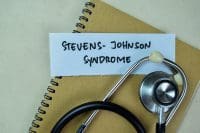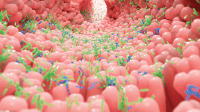Imagine being afraid to leave the house for fear you’ll lose bowel control. That’s what some people with irritable bowel syndrome (IBS) go through on a monthly, weekly, or even daily basis. Obviously, IBS can significantly reduce the quality of life and work productivity. In some cases, quality of life declines enough to increase suicidal behavior.
Chronic but benign, IBS is considered a functional disorder because symptoms persist despite a negative examination for GI abnormalities. It accounts for approximately 25% to 50% of gastroenterologist referrals and is one of the most common complaints among patients seeing primary care physicians.
Predominant manifestations of IBS (also called spastic or irritable colon) are abdominal pain and altered bowel habits. IBS pathophysiology remains unclear, but the condition doesn’t lead to development of cancer. (Take care not to confuse IBS with inflammatory bowel disease, such as Crohn’s disease or membranous ulcerative colitis.)
In 2009, the American College of Gastroenterology (ACG) updated its guidelines for IBS diagnosis and treatment. This article reflects the revised ACG guidelines.
Who gets it
IBS affects the young and the old, males and females (although it’s twice as common in women). Many sufferers are younger than age 50. One study found that while IBS prevalence is similar across all racial and ethnic groups, it’s higher in persons with annual incomes below $20,000 and in unemployed and unmarried persons. It has been recognized as a key component of Gulf War syndrome, a multisymptom disorder affecting soldiers deployed in the 1991 Gulf War.
IBS subtypes
IBS occurs in three subtypes, identified by their predominant symptoms:
- diarrhea-predominant IBS (IBS-D)
- constipation-predominant IBS (IBS-C)
- mixed IBS (IBS-M), in which diarrhea alternates with constipation.
IBS-D and IBS-M are more prevalent than IBS-C. Some evidence suggests that in some persons who initially have one subtype, symptoms eventually switch to those of another subtype. (See Classifying IBS by clicking the PDF icon above.)
Causes
Studies have identified potential risk factors, such as heredity, environment, visceral hypersensitivity, food hypersensitivities, abnormal GI motility, previous GI infections, emotional stress, and a history of physical or sexual abuse. (See IBS risk factors by clicking the PDF icon above.) About 50% of persons with IBS also have signs and symptoms of depression, anxiety, somatization, or personality disorders.
Assessment
The primary complaint among IBS patients is abdominal pain with altered bowel habits for a period of at least 3 months. The pain, typically felt in the left lower abdomen, is crampy with variable duration and intensity. It varies with each individual, may worsen with eating or emotional stress, and may ease with defecation.
Certain types of abdominal pain are not characteristic of IBS and should be investigated further. These include pain associated with anorexia, malnutrition, or weight loss and progressive pain that awakens the person or prevents sleep.
Altered bowel habits
In IBS patients, the range of bowel habits is broad and can vary from diarrhea to constipation, diarrhea alternating with constipation, and normal bowel habits alternating with either diarrhea or constipation.
Diarrhea. In IBS, diarrhea typically is marked by frequent loose stools of small to moderate volume, occurring during waking hours and linked to awakening or eating a meal. Some patients complain of cramping and urgency, fecal incontinence, a feeling of incomplete evacuation, and mucus discharge. Up to 17% of IBS occurrences seem to follow acute viral or bacterial gastroenteritis caused by Campylobacter, Salmonella, or Shigella infections. Large-volume or nighttime diarrhea, bloody stools, and greasy stools are not typical of IBS and should be investigated.
Constipation. This may last from days to months, with remissions of normal stools or diarrhea. Patients may report a feeling of incomplete evacuation without producing stool, straining at stool, and prolonged bathroom times. Some may report using enemas or laxatives for relief.
Other GI complaints. Other complaints may include gastroesophageal reflux, dysphagia, early satiety, intermittent dyspepsia, nausea, noncardiac chest pain, bloating, or increased gas production. Some patients are sensitive to dairy foods, fried foods, fats, caffeine, carbonated beverages, and red meat.
Extraintestinal conditions
Extraintestinal conditions possibly associated with IBS include dysmenorrhea, dyspareunia, increased urinary frequency and urgency, hypertension, reactive airway disease, and rheumatologic syndromes.
Diagnosis
No symptom-based diagnostic criteria can identify IBS syndrome accurately. Evaluation of patients with abdominal pain and altered bowel habits must exclude colitis, inflammatory bowel disease, celiac disease, lactose intolerance, infection, diverticula, pancreatic insufficiency, thyroid malfunction, cancer, pelvic-floor dyssynergia, and psychiatric disorders.
For patients who present with abdominal pain and altered bowel habits, ACG advises clinicians to evaluate the history for hematochezia, weight loss greater than 10 lb (4.5 kg), recurring fever, anemia, chronic severe diarrhea, and a family history of colorectal cancer. These “alarm” factors should be investigated for a potential organic cause.
No specific laboratory tests diagnose IBS. In patients without alarm factors, obtain a detailed history of nutritional intake and signs and symptoms. ACG guidelines don’t recommend laboratory testing, such as a chemistry panel, complete blood count, thyroid function studies, inflammatory markers, stool studies for ova and parasites and fecal fat, or testing for celiac disease or lactose malabsorption. Unless the patient has alarm features, such tests aren’t likely to identify an organic condition. Patients older than age 50 should have routine colon-cancer screenings, but in younger patients, a sigmoidoscopy or colonoscopy isn’t necessary and adds little to IBS diagnosis or treatment.
Management
Current treatment focuses on symptom management. An effective management plan takes an integrated gradual approach. It includes individualized patient education and dietary modification with a holistic focus that addresses the physical, psychological, and emotional dimensions of the disorder. Caregivers should strive to develop a trusting, therapeutic relationship with the patient, starting with simple reassurance.
For some patients with severe symptoms, lifestyle modification, medications, and treatment of psychological factors (such as depression, anxiety, or other psychiatric conditions) are indicated. Little evidence supports the efficacy of specific treatments for all IBS patients.
Dietary changes
Current evidence indicates food-allergy testing and exclusion diets aren’t effective in managing IBS. Psyllium hydrophilic mucilloid (ispaghula husk) is moderately effective. For some patients, increasing soluble fiber intake provides relief.
Teach patients to eat regularly and slowly. Advise them to avoid drinking liquids with meals, dietary excesses, gas-producing or spicy foods, and chewing gum. Some patients find probiotic foods and supplements (containing so-called “good” bacteria) effective, although studies don’t show consistent results when compared to placebo. In some patients, probiotic-containing yogurt may improve the balance of normal intestinal flora and ease symptoms.
Chinese herbal mixtures have been studied in randomized clinical trials and appear to have some benefit. But they may contain various components, and their purity varies. They aren’t recommended as some have been linked to liver failure.
Pharmacologic therapy
For abdominal pain and discomfort, certain antispasmodics (such as hyoscine, peppermint oil, cimetropium, and pinaverium) may provide short-term relief. In addition, anticholinergics, calcium channel blockers, combination sedative-anticholinergics, and antidepressants may be prescribed for pain relief.
Nonabsorbable antibiotics such as rifaximin have been effective in 8% to 23% of IBS patients with diarrhea, reducing both global IBS symptoms and bloating. While not FDA-approved for IBS, rifaximin is approved for traveler’s diarrhea. In IBS trials, the rifaximin dosage was higher and therapy duration was longer than when used for traveler’s diarrhea.
Diarrhea may improve with lo-peramide (Imodium). Although this drug may not effectively reduce pain or bloating, it does help reduce the number of stools and improve stool consistency. Alosetron hydrochloride (Lotronex), introduced to treat diarrhea-predominant IBS in women, was removed from the market due to the risk of ischemic colitis and severe constipation. Later it was reintroduced only for select patients under close supervision.
Constipation may improve with prescribed osmotic laxatives or bulking agents. Tegaserod (Zelnorm), prescribed for certain women with IBS-C, has been taken off the market due to the risk of myocardial infarction, stroke, and unstable angina. Lubiprostone (Amitiza), which improved global IBS-C symptoms in randomized clinical trials, is FDA-approved for women with IBS-C. It’s also approved for chronic idiopathic constipation, and so far it appears to be safe and effective for that purpose. But more research on the drug’s effectiveness and safety is needed. The most common side effects are mild to moderate nausea and diarrhea. Lubiprostone enhances fluid secretion and softens bowel movements; for IBS-C, it’s given at one-third the dosage used in treating chronic constipation. The drug shouldn’t be taken by patients with mechanical bowel obstruction or preexisting diarrhea. Women of childbearing age should have a documented negative pregnancy test before starting ther-apy and must use contraception during therapy.
Stress reduction
Patients should be screened to assess their anxiety level, coping ability, emotional support system, and commitment to adhering to treatment. Alternative and complementary therapies, such as acupuncture, hypnosis, fish oils, and peppermint oil, have been effective for some patients. Performing breathing and relaxation exercises, getting regular exercise, and maintaining rest patterns also can be effective. For some patients, psychological counseling, support groups, cognitive therapy, dynamic psychotherapy, and hypnotherapy can help reduce global IBS symptoms by reducing stress.
Partner with patients
You’re likely to encounter IBS patients in various clinical settings. To ensure their accurate diagnosis and management, inform yourself about the condition and use an integrated management approach. Help your patients understand this complex condition and work with them to improve their quality of life.
Selected references
American College of Gastroenterology Task Force on IBS. An evidence-based systematic review on the management of irritable bowel syndrome. Am J Gastroenterol. 2009;104 (suppl 1):S1-S34.
Andrews EB, Eaton SC, Hollis KA, et al. Prevalence and demographics of irritable bowel syndrome: results from a large web-based survey. Aliment Pharmacol Ther. 2005;22(10):935-942.
Jamieson AE, Fletcher PC, Schneider MA. Seeking control through the determination of diet: a qualitative investigation of women with irritable bowel syndrome and inflammatory bowel disease. Clin Nurse Spec. 2007;21(3):152-160.
Moore J. Uncovering the link between irritable bowel syndrome and abuse. Nurs N Z. 2008;14(7):22-23.
O’Mahony L, McCarthy J, Kelly P, et al. Lactobacillus and bifidobacterium in irritable bowel syndrome: symptom responses and relationship to cytokine profiles. Gastroenterology. 2005;128(3):541-551
Spiegel BM, Farid M, Esrailian E, Talley J, Chang L. Is irritable bowel syndrome a diagnosis of exclusion?: a survey of primary care providers, gastroenterologists, and IBS experts. Am J Gastroenterol. 2010;105(4):848-858.
Wald A. Pathophysiology of irritable bowel syndrome.UpToDate. www.uptodate.com/
contents/pathophysiology-of-irritable-bowel-syndrome. Accessed July 14, 2011.
Zijdenbos IL, de Wit NJ, van der Heijden GJ, Rubin G, Quartero, AO. Psychological treatments for the management of irritable bowel syndrome. Cochrane Database Syst Rev. 2009;Jan 21(1):CD006442.
Visit www.AmericanNurseToday.com for a complete list of references.
Click the PDF icon above for a ist of dietary do’s and don’ts.
Patti Radovich is a clinical nurse specialist and manager of nursing research at Loma Linda University Medical Center in Loma Linda, California.

















